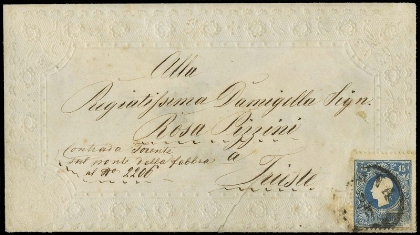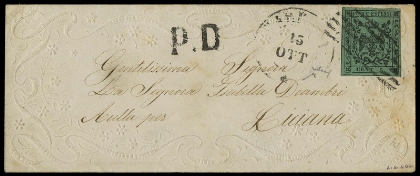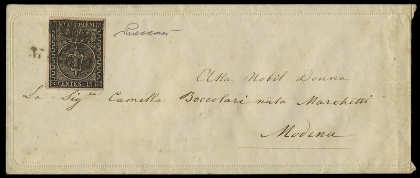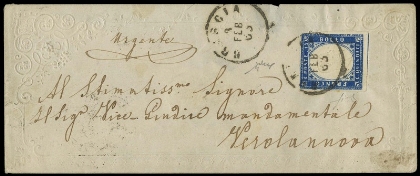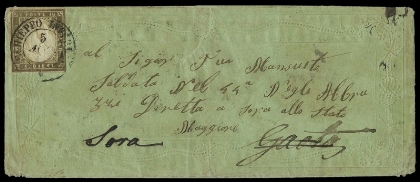Messages of love? Maybe, or maybe not. What these letters convey at first sight is the elegance and care taken over postal messages one and a half centuries ago.
Addressed to women – and sometimes men
Who knows what was inside the envelope franked with the first type of Lombardy-Venetia 15 soldi, sent in 1858 to the “honourable maiden” Rosa Pizzini of Trieste, which is to go under the hammer at Zanaria Aste on May 5th.
One and a half centuries later, it’s difficult to tell. Judging from the visual details, the care with which the address has been written, the stamp placed tidily in one corner and, above all, the kind of paper chosen, featuring a series of delicate decorations in relief, it is clear that the sender really cared about that letter, and hoped that it would be warmly received by the addressee.
The experts call these objects “valentines”, in the Anglo-American tradition. They are the predecessors of the messages that lovers exchange even today, using traditional paper letters, perhaps accompanied with a box of chocolates or a bouquet of flowers, or by more modern means of communication. Meanwhile, period “valentines” form the basis for collections which combine philatelic and postal history research with a simple taste for the beautiful things in life. Not forgetting the financial value: the envelope described above, for example, will have a starting price of 250.00 Euros, and will go to the highest bidder.
This won’t be the only valentine on offer at the auction. Another example is the envelope stamped in 1852 with the green 5 centesimi from Modena, with a full stop after the figure. Once again, the addressee is a lady, resident in Liciana. This letter is also embellished with floral festoons in relief, which, together with the franking, go towards setting the starting price: 500.00 Euros. The ornamentation on a third lot is decidedly more understated. This envelope travelled in the same year, 1852, with a black on pink 15 centesimi from Parma, sent to Modena. Given the rarity of valentines sent from the Duchy of Parma, the starting price is 800.00 Euros. Such letters were generally sent to female recipients. But not always, as we see from a fourth item, sent in 1861 to a soldier stationed at Gaeta, and later redirected to Sora. It made a fairly complex journey, as we can tell from no less than nine transit postmarks on the back. The journey was paid for with an olive grey Sardinian 10 centesimi, with a flaw in the upper left hand corner. The item is valued at a starting price of 300.00 Euros. An additional document is also addressed to a male recipient, and once again features ornamental decorations. It’s dated 1863 and was sent urgently (underlined by the sender) to Verolanuova. Postage was paid with a light blue Sardinian 15 centesimi. Bidding for this piece starts at 500.00 Euros.
This won’t be the only valentine on offer at the auction. Another example is the envelope stamped in 1852 with the green 5 centesimi from Modena, with a full stop after the figure. Once again, the addressee is a lady, resident in Liciana. This letter is also embellished with floral festoons in relief, which, together with the franking, go towards setting the starting price: 500.00 Euros. The ornamentation on a third lot is decidedly more understated. This envelope travelled in the same year, 1852, with a black on pink 15 centesimi from Parma, sent to Modena. Given the rarity of valentines sent from the Duchy of Parma, the starting price is 800.00 Euros. Such letters were generally sent to female recipients. But not always, as we see from a fourth item, sent in 1861 to a soldier stationed at Gaeta, and later redirected to Sora. It made a fairly complex journey, as we can tell from no less than nine transit postmarks on the back. The journey was paid for with an olive grey Sardinian 10 centesimi, with a flaw in the upper left hand corner. The item is valued at a starting price of 300.00 Euros. An additional document is also addressed to a male recipient, and once again features ornamental decorations. It’s dated 1863 and was sent urgently (underlined by the sender) to Verolanuova. Postage was paid with a light blue Sardinian 15 centesimi. Bidding for this piece starts at 500.00 Euros.
